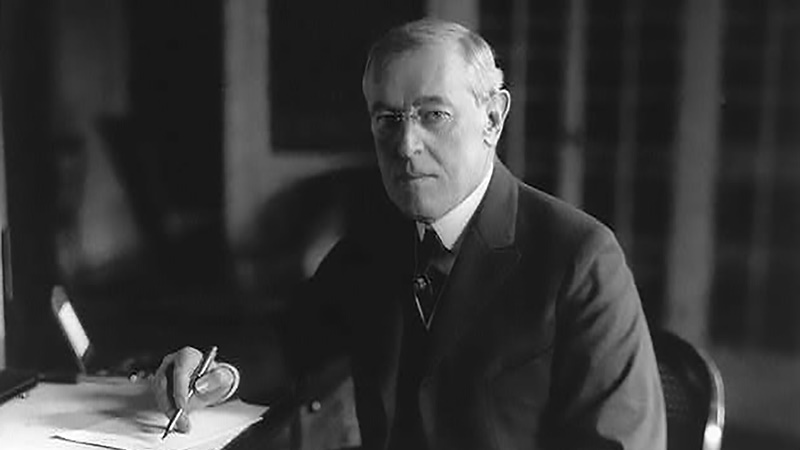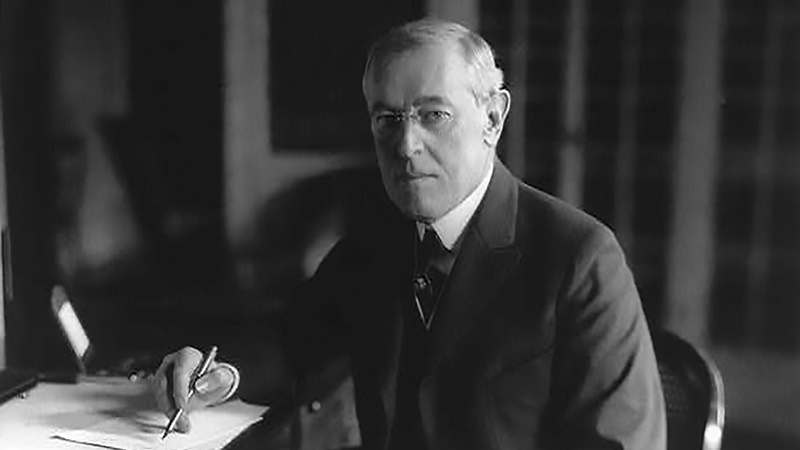It actually was a response to both the Bolshevik Revolution of October/November 1917 and British Prime Minister David Lloyd George’s speech on war aims of January 5, 1918. Wilson deliberately separated himself from the Allies by defining the United States as an “Associated” Power and felt that Lenin’s international program was a challenge to his League of Nations idea.
The Fourteen Points were indeed 14 only for a short while. 34 days later, on February 11, Wilson proclaimed “Four Principles” of peace and on September 25 he added “Five Particulars” to run the count up to 23. Meanwhile, some of the original 14 also transformed. As the military situation developed and the war came to a drastic end in six weeks between September 30 and November 11, 1918, haggling for postwar territorial favors began within (and without) the Allied camp.

President Woodrow Wilson
Wilson sent Col. Edward M. House, his “alter ego” and unofficial national security adviser, to Europe to negotiate the Armistice with the Central Powers. House got tired of repeated requests for favors and clarifications, and tasked Walter Lippmann and Frank I. Cobb with writing a detailed commentary on the Fourteen Points. Lippmann then was a young liberal journalist of New Republic fame serving in US intelligence, while Cobb was editor of the New York World. The “Lippmann-Cobb commentary” (version four in 11 months) was cleared with Wilson on October 29-30, 1918 and was duly printed in the western press.
Meanwhile, tens of thousands of copies of the original speech and some of the addenda were printed in German and smuggled into Austria-Hungary by a couple of hard-boiled woman activists: Vira Borman Whitehouse, the first American woman diplomat, and Rosika Schwimmer, an iconic Hungarian feminist then serving as Károlyi’s ambassador to Switzerland. This took place at the turn of October-November 1918, just as the war was ending.
Thus, at the end of the war multiple versions and interpretations of the Fourteen Points were at play simultaneously in the European media. The Ballhausplatz tried to play this to its advantage, insisting that Vienna had asked for peace on the basis of the original version. The State Department promptly replied that the original point 10 was no longer in effect. So began the postwar interpretative war over the Fourteen Points.
Or, maybe not. When the speech was delivered on January 8, 1918, Wilson was immediately asked about point 10, which reads, “The people of Austria-Hungary, whose place among the nations we wish to see safeguarded and assured, should be accorded the freest opportunity to autonomous development.” He responded differently to queries, depending on who asked him. To his Secretary of the Navy, Josephus Daniels, he confided that this did not constitute an attempt to intervene in the internal affairs of an existing country, Austria-Hungary, while he told French Ambassador Jean J. Jusserand that that it indeed meant (possible) support for the dismemberment of the Habsburg Empire.
Wilson’s address was arguably the first 20th-century speech that achieved mythic proportions and came to stand for many things not actually included in it. It was digested and wistfully misrepresented in interwar Hungary then ignored for 40 years of communist rule. It is now being studied by the “Lendület” Trianon 100 study group of the Hungarian Academy.
For details see the articles by Tibor Glant "The Myth and History of Woodrow Wilson‘s Fourteen Points in Hungary" (in Eger Journal of American Studies /ed. Lehel Vadon, Department of American Studies Eszterházy Károly College, Eger/, Volume XII/1–2 2010), and "Against All Odds: Vira B. Whitehouse and Rosika Schwimmer in Switzerland, 1918" (in American Studies International, February 2002, Vol. XL, No. 1.): see the attached files!
 download file ,
download file ,
 download file
download file 





